
The retail construction industry involves the design, construction, and renovation of buildings for retail purposes. It encompasses a range of projects, including shopping centers, supermarkets, department stores, and specialty shops. The industry is highly competitive and constantly evolving, with a focus on creating attractive and functional spaces for consumers to shop and interact with brands. Trends in the industry include the incorporation of technology and sustainability into retail construction projects.
GAO RFID Inc., one of the global top 10 RFID leaders, is based in the cities of New York and Toronto and it has deployed many RFID, BLE and IoT projects in the retail construction industry.
GAO RFID Systems & Hardware for Retail Construction
GAO RFID Inc. offers the largest selection of BLE gateways, BLE beacons, RFID readers, tags, antenna, printers, and integrated RFID systems for various industries, including retail construction.
BLE (Bluetooth Low Energy)
GAO offers advanced BLE gateways:
as well as versatile beacons with such important functions as temperature, humility, vibration and panic button:
GAO’s BLE technology is suitable for all kinds of industries, including restaurant construction.
UHF (Ultra High Frequency) RFID
GAO offers the largest selection of UHF RFID readers for various industries, including restaurant construction:
GAO RFID offers the widest choice of UHF RFID tags, labels, badges, wristbands for various industries, including restaurant construction:
and an array of antennas to address different applications:
HF (High Frequency), NFC (Near Field Communications) and LF (Low Frequency) RFID
GAO offers the largest selection of HF, NFC, and LF RFID readers for various industries, including restaurant construction:
- High Frequency 13.56 MHz Passive RFID Readers
- Low Frequency 134 kHz Passive RFID Readers
- Low Frequency 125 kHz Passive RFID Readers
HF, NFC and LF RFID tags, labels, badges, wristbands for various industries, including restaurant construction:
and antennas:
GAO also offers RFID printers:
Digital I/O adapters:
and relay controllers:
For embedded applications, GAO offers UHF, HF and LF RFID reader modules:
- UHF 860 – 960 MHz RFID Modules
- 13.56 MHz High Frequency RFID Modules
- 125 kHz Low Frequency RFID Modules
The RFID systems by GAO are highly popular for clients in restaurant construction:
People or workers tracking system:
Physical asset or operational equipment tracking system:
Personnel or people access control system:
Parking or vehicle control system:
There are two versions of GAO’s software, one is running on a local server, and another running in the cloud.
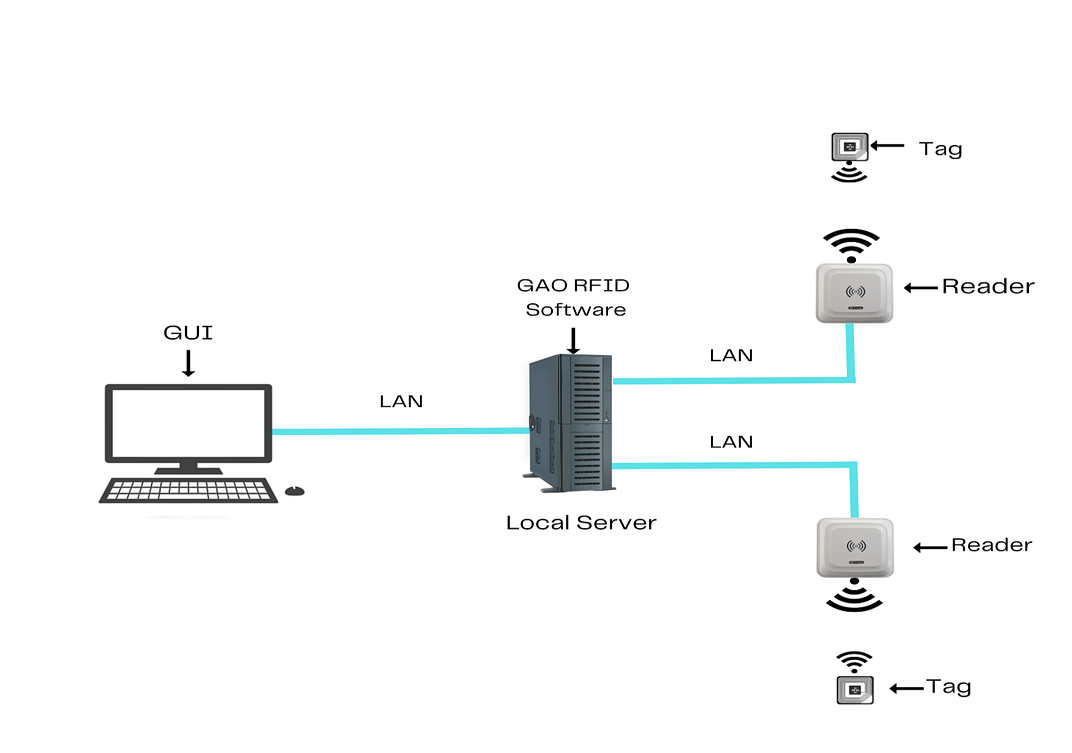 GAO’s Software Runs on a Local Server
GAO’s Software Runs on a Local Server
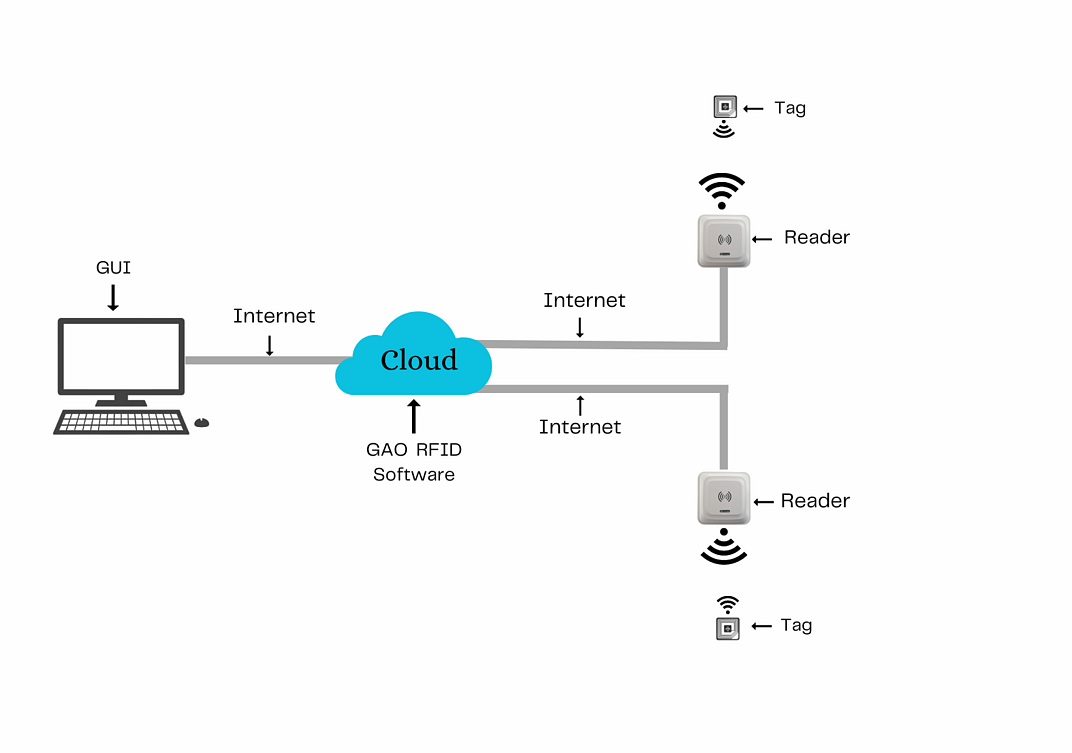 GAO’s Software Runs in the Cloud
GAO’s Software Runs in the Cloud
GAO offers free samples of its RFID tags, labels, badges, and wristbands
GAO offers free trial for all of its software available.
Applications & Benefits of GAO’s RFID, BLE, IoT & Drones for the Retail Construction:
Applications & benefits of applying RFID to retail construction:
- Asset management: GAO`s RFID technology can be used to track construction equipment and materials, such as excavators, cranes, power tools and concrete blocks reducing loss and theft while optimizing utilization rates. This helps construction firms save time and money by ensuring that equipment is in the right place at the right time.
- Tool tracking: The implementation of our RFID tags can be attached to tools, such as saws, drills, and hammers, helping construction workers keep track of their tools and reducing the risk of lost or stolen equipment.
- Safety: Our RFID technology can also be used to improve safety on construction sites. For example, RFID-enabled personal protective equipment (PPE) can track which workers are wearing the required safety gear, ensuring compliance with safety regulations.
- Quality Control: By utilizing GAO’s RFID technology, construction firms can track the movement of materials and components throughout the construction process, ensuring that the right materials are used in the right place and at the right time. This helps to improve quality control and reduce waste.
Applications & benefits of applying BLE technology to the retail construction:
- Indoor navigation: Our BLE technology can be used to create indoor maps and way-finding systems for construction sites, helping workers navigate complex and changing environments.
- Access control: Improving security, our BLE sensors can be used for access control, allowing authorized personnel to enter and exit restricted areas on construction sites. For instance, BLE sensors can be installed at entrances to restricted areas such as equipment storage or hazardous material storage areas.
- Remote monitoring: GAO’s BLE technology can be used for remote monitoring of construction sites, providing real-time data on construction progress, equipment utilization, and worker productivity, allowing construction firms to make data-driven decisions and optimize their operations.
Applications & benefits of applying combination of RFID and drones to the retail construction:
- Site planning: Drones equipped with GAO’s RFID readers can be used to survey construction sites and create detailed 3D models, providing valuable data for site planning and design.
- Environmental monitoring: Drones equipped with our sensors can monitor environmental conditions on construction sites, such as air quality and noise levels, helping construction firms to comply with regulations and minimize their impact on the environment.
- Equipment maintenance: The use our RFID sensors with drones can perform maintenance inspections, monitoring the condition of construction equipment, detecting potential issues before they cause equipment failure, reducing downtime and ensuring that equipment is kept in good working order.
- Inventory management: RFID tags can be attached to construction materials and equipment such as lumber, piping, or electrical conduit. As these are moved around a construction site, IoT sensors can track their location and movement in real-time, improving inventory accuracy and reducing human labor.
Applications & benefits of applying combination of RFID and IoT to the retail construction:
- Sustainability: IoT sensors combined with our RFID technology can be used to monitor construction site conditions, such as air quality and noise levels, helping construction firms to comply with regulations and minimize their impact on the environment.
- Asset tracking: Our RFID tags can be attached to construction equipment and vehicles, and IoT sensors can be used to track their location and condition in real-time, reducing loss and theft and improving maintenance.
- Energy efficiency: Improving energy savings, GAO’s RFID technology combined with IoT sensors can be used to monitor energy usage on construction sites, identifying opportunities for efficiency improvements and cost savings. For instance, tracking the energy consumption of lighting and heating, ventilation, and air conditioning systems. It can be automatically adjusted to reduce energy consumption in those areas.
GAO Helps Customers Comply with Standards, Mandates & Regulations of the Retail Construction
GAO RFID Inc. has helped many companies in the retail construction industry to deploy RFID systems and to ensure such deployments complying with the applicable industry standards, mandates and government regulations:
- OSHA (Occupational Safety and Health Administration): A federal agency that sets and enforces safety and health standards in the workplace, including construction sites.
- NFPA (National Fire Protection Association): An organization that develops and publishes fire safety standards, including those related to building construction and maintenance.
- ASTM (American Society for Testing and Materials): An organization that develops and publishes voluntary consensus standards for a wide range of industries, including construction and building materials.
- ICC (International Code Council): An organization that develops and publishes model codes and standards for building safety and construction.
- ANSI (American National Standards Institute): A nonprofit organization that oversees the development of voluntary consensus standards for various industries, including construction.
- LEED (Leadership in Energy and Environmental Design): A certification program that sets standards for sustainable building design and construction.
- ENERGY STAR: A certification program that promotes energy efficiency in products, buildings, and homes.
- EPA (Environmental Protection Agency): Sets and enforces environmental regulations related to air and water quality.
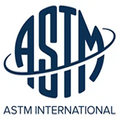 American Society for Testing and Materials
American Society for Testing and Materials
 National Fire Protection Association
National Fire Protection Association
 Environmental Protection Agency
Environmental Protection Agency
 Occupational Safety and Health Administration
Occupational Safety and Health Administration
 Leadership in Energy and Environmental Design
Leadership in Energy and Environmental Design
 ENERGY STAR
ENERGY STAR
GAO’s Software Provides API
GAO’s popular RFID software such as personnel tracking, asset tracking, access control, parking system control offers a free trial and offers an API to each of the common software in the retail construction industry:
Personnel management:
- Recruitment and onboarding: Using technology to automate tasks such as posting job openings, screening resumes, and completing new hire paperwork streamlines the recruitment and onboarding process. This saves time, reduces errors, and enables new employees to join the company more quickly and smoothly.
- Time and attendance tracking: Automating time and attendance tracking using software means employees don’t have to manually enter their work hours, breaks, and time off. The software captures this information automatically, reducing errors and improving payroll accuracy. It also streamlines payroll processes and saves time and resources.
- Employee self-service: Provides employees with access to their own data, such as schedules, time off requests, and pay stubs, reducing administrative workload and improving employee satisfaction.
- Learning management: Employee training involves identifying needs, designing and delivering programs, and evaluating effectiveness. Effective training enhances employee performance, satisfaction, retention, and adaptability, leading to increased productivity, quality, and customer satisfaction, and improved competitiveness..
Equipment management:
- Visual aids and step-by-step instructions: Improving augmented reality tools are software applications that utilize advanced technologies like 3D modeling and real-time data to provide technicians with visual aids and step-by-step instructions for equipment maintenance and repairs. These applications can be accessed through mobile devices or AR headsets, enabling technicians to view equipment in 3D and quickly identify problem areas.
- Fleet management: This software is used to track and manage a company’s fleet of vehicles and equipment. It can provide various functionalities like scheduling and tracking maintenance tasks, monitoring fuel usage, and ensuring driver safety. The software can also help optimize routes and monitor driver behavior to improve fuel efficiency and reduce costs.
- Mobile management: Allow users to scan equipment with their mobile devices, which then provides them with access to the equipment’s usage history, maintenance records, and current inventory levels. Helping managers to make informed decisions.
- Safety compliance: Ensuring compliance with safety regulations by tracking equipment inspections, certifications, and maintenance records. This ensures that all equipment is in safe and reliable condition before use.
Supply chain management:
- Demand forecasting: Uses historical data and statistical models to forecast demand for products and materials. This helps managers optimize inventory levels and minimize stockouts.
- Vendor-managed inventory: Allows suppliers to monitor inventory levels and automatically replenish stock when necessary. This can help reduce lead times and improve supply chain efficiency.
- Supplier collaboration: Ensuring timely delivery of resources and equipment. Providing a platform for effective communication and collaboration between the company and its suppliers, allowing for real-time updates on inventory levels, order status, and delivery schedules.
- Prevent delays: This involves analyze data from various sources, such as past delivery times, weather forecasts, and traffic patterns, to predict future delivery times and identify potential issues that may cause delays. Helping managers make informed decisions and take proactive measures to prevent delays.
Other applications:
- Smart contracts: Automate and streamline the procurement process by allowing for automated verification, approval, and payment of orders. This can help reduce administrative costs and improve efficiency in the procurement process.
- Cloud-based collaboration: Real-time collaboration software enables construction teams to work together from anywhere using cloud-based platforms, sharing project information and updates instantly. This improves communication and reduces delays, leading to faster project completion, better quality work, and improved client satisfaction.
- Customer relationship management: Using to manage customer interactions and relationships. In the retail construction industry, it is used to manage customer accounts, track service requests, and improve customer satisfaction.
- Accounting management: Handle various financial processes, such as invoicing, payroll, and budgeting. With this software, companies can generate accurate financial reports, track expenses, and manage cash flow. It can also automate many of the financial processes, saving time and reducing errors.
Case Studies of RFID Applications
A case study of RFID application in the retail construction industry in the U.S.:
Hensel Phelps Construction utilized RFID technology for a large-scale renovation and expansion project of a shopping mall in the US. RFID tags were used to track delivery, storage, and installation of construction materials and equipment, while RFID readers were installed at key locations to ensure accurate delivery. The RFID system streamlined material management, reduced manual labor, and improved inventory accuracy. Real-time monitoring of materials also prevented theft and loss. The system demonstrated the potential for RFID technology to improve productivity and efficiency in the retail construction industry, while reducing costs and risks associated with manual processes.
Another case study of RFID application in the retail construction industry in the U.S.:
McCarthy Building Companies used RFID technology to track construction materials and equipment for a large retail store project. RFID readers were placed at various locations to capture real-time movement of materials. The RFID system allowed McCarthy to manage inventory more efficiently, monitor the location and status of construction materials and equipment, and improve safety by providing real-time data on the location of workers and equipment. This demonstrated the potential of technology to optimize construction processes and enhance productivity and safety in the retail construction industry.
GAO Has Served the Retail Construction Extensively
GAO RFID Inc., one of the global top 10 RFID leaders, is based in the cities of New York and Toronto and it has deployed RFID, BLE and IoT projects for many leading companies in the retail construction industry, including its various divisions such as:
- General contracting: These companies manage and oversee all aspects of a construction project, including planning, design, budgeting, and construction.
- Design-build: Involves design and construction services to clients, offering a more streamlined approach to project management.
- Construction management: These companies work as a consultant to the client, overseeing the planning, design, and construction process to ensure that the project is completed on time and within budget.
- Specialty trade contractors: A division specialize in specific trades such as electrical, plumbing, or HVAC and provide services to general contractors or directly to clients.
- Remodeling: Involves specialize industries in renovating and updating existing retail spaces to meet the needs of clients and customers.
- Facilities maintenance: Involves industries that deals with provide ongoing maintenance and repair services to retail facilities, ensuring that they are safe and fully operational.
List of the leading companies in the Retail Construction in the U.S.
 Gray Construction
Gray Construction
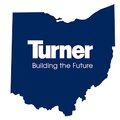 Turner Construction Company
Turner Construction Company
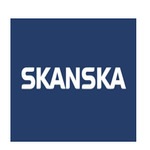 Skanska USA Inc.
Skanska USA Inc.
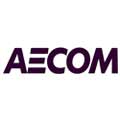 AECOM Company
AECOM Company
 Jacobs Engineering Group Incorporated
Jacobs Engineering Group Incorporated
 Fluor Corporation
Fluor Corporation
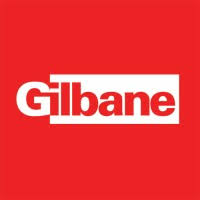 Gilbane Building Company
Gilbane Building Company
 Mccarthy Building Companies Inc.
Mccarthy Building Companies Inc.
 Hensel Phelps Construction Company
Hensel Phelps Construction Company
 Clark Construction Company
Clark Construction Company
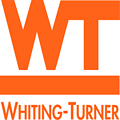 Whiting-Turner Contracting Company
Whiting-Turner Contracting Company
 PCL Construction Enterprises
PCL Construction Enterprises
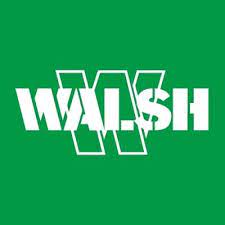 Walsh Construction Company
Walsh Construction Company
 Kiewit Corporation
Kiewit Corporation
 Sundt Construction
Sundt Construction
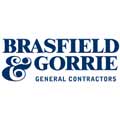 Brasfield & Gorrie, LLC
Brasfield & Gorrie, LLC
 Suffolk Construction Company
Suffolk Construction Company
 Mortenson Construction Company
Mortenson Construction Company
List of the leading companies in the restaurant construction industry in the Canada
 EllisDon Corporation
EllisDon Corporation
 Graham Construction and Engineering Incorporated
Graham Construction and Engineering Incorporated
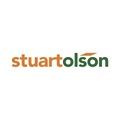 Stuart Olson Incorporated
Stuart Olson Incorporated
 Bird Construction Incorporated
Bird Construction Incorporated
 Ledcor Group of Companies
Ledcor Group of Companies
 Chandos Construction Limited
Chandos Construction Limited
